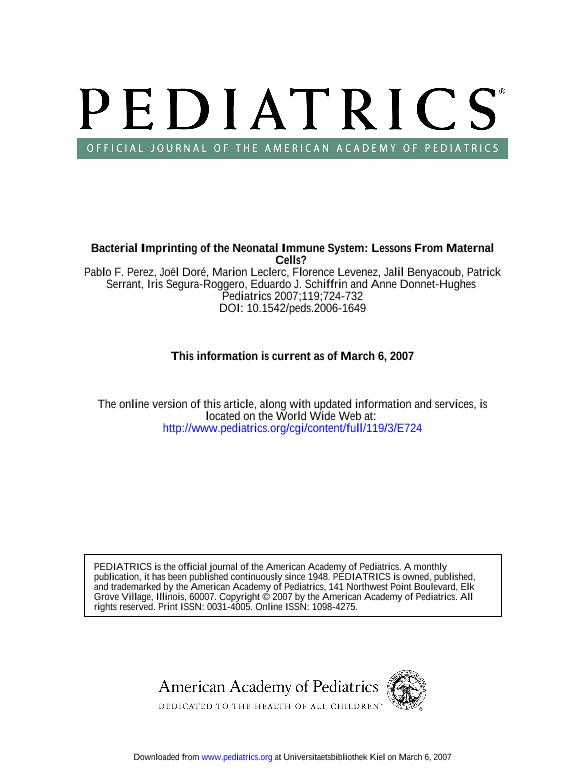Artículo
Bacterial Imprinting of the Neonatal Immune System: Lessons From Maternal Cells?
Perez, Pablo Fernando ; Doré, Joel; Leclerc, Marion; Levenez, Florence; Benyacoub, Jalil; Serrant, Patrick; Segura Roggero, Iris; Schiffrin, Eduardo J.; Donnet Hughes, Anne
; Doré, Joel; Leclerc, Marion; Levenez, Florence; Benyacoub, Jalil; Serrant, Patrick; Segura Roggero, Iris; Schiffrin, Eduardo J.; Donnet Hughes, Anne
 ; Doré, Joel; Leclerc, Marion; Levenez, Florence; Benyacoub, Jalil; Serrant, Patrick; Segura Roggero, Iris; Schiffrin, Eduardo J.; Donnet Hughes, Anne
; Doré, Joel; Leclerc, Marion; Levenez, Florence; Benyacoub, Jalil; Serrant, Patrick; Segura Roggero, Iris; Schiffrin, Eduardo J.; Donnet Hughes, Anne
Fecha de publicación:
06/2007
Editorial:
American Academy of Pediatrics
Revista:
Pediatrics
ISSN:
0031-4005
e-ISSN:
1098-4275
Idioma:
Inglés
Tipo de recurso:
Artículo publicado
Clasificación temática:
Resumen
OBJECTIVE. We examined the presence of a natural bacterial inoculum in breast milk and its intracellular transport from the maternal intestine to the breast through the circulation. METHODS. Breast milk and peripheral blood were collected aseptically from healthy donors at various times after delivery, and the presence of viable bacteria was determined through plating. Temporal temperature gradient gel electrophoresis was used to examine the bacterial ribosomal DNA content in milk cells, maternal peripheral blood mononuclear cells, and feces and in corresponding infant feces. Blood from nongravid nonlactating women served as control samples. Bacterial translocation to extraintestinal tissues was also evaluated in virgin, pregnant, and lactating mice. RESULTS. Breast milk contained a low total concentration of microbes of <103 colony-forming units per mL. Temporal temperature gradient gel electrophoresis revealed that maternal blood and milk cells contained the genetic material of a greater biodiversity of enteric bacteria. Some bacterial signatures were common to infant feces and to samples of maternal origin. Bacterial translocation from the gut to mesenteric lymph nodes and mammary gland occurred during late pregnancy and lactation in mice. CONCLUSIONS. Bacterial translocation is a unique physiologic event, which is increased during pregnancy and lactation in rodents. Human breast milk cells contain a limited number of viable bacteria but a range of bacterial DNA signatures, as also found in maternal peripheral blood mononuclear cells. Those peripheral blood mononuclear cells showed greater biodiversity than did peripheral blood mononuclear cells from control women. Taken together, our results suggest that intestinally derived bacterial components are transported to the lactating breast within mononuclear cells. We speculate that this programs the neonatal immune system to recognize specific bacterial molecular patterns and to respond appropriately to pathogens and commensal organisms.
Archivos asociados
Licencia
Identificadores
Colecciones
Articulos(CIDCA)
Articulos de CENTRO DE INV EN CRIOTECNOLOGIA DE ALIMENTOS (I)
Articulos de CENTRO DE INV EN CRIOTECNOLOGIA DE ALIMENTOS (I)
Citación
Perez, Pablo Fernando; Doré, Joel; Leclerc, Marion; Levenez, Florence; Benyacoub, Jalil; et al.; Bacterial Imprinting of the Neonatal Immune System: Lessons From Maternal Cells?; American Academy of Pediatrics; Pediatrics; 119; 3; 6-2007; e724-e732
Compartir
Altmétricas



